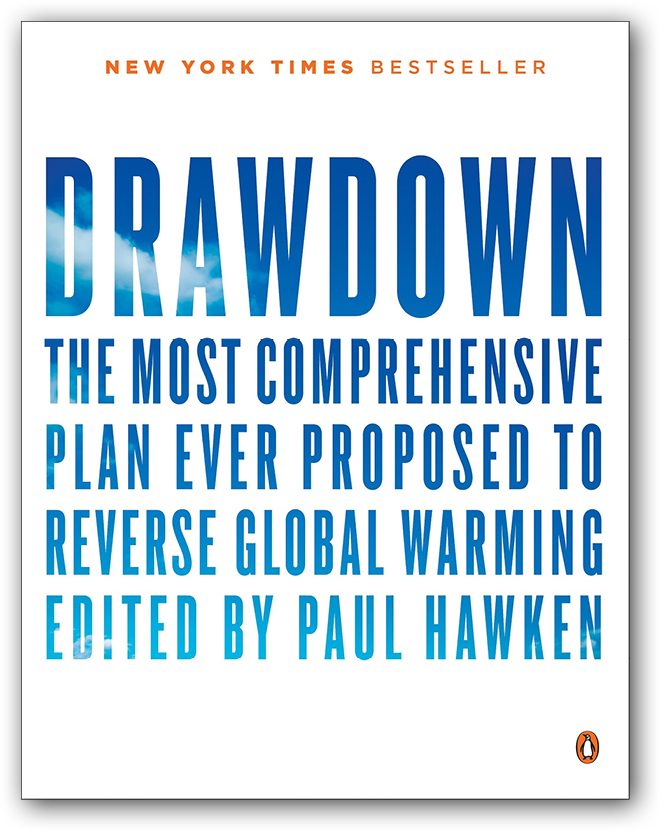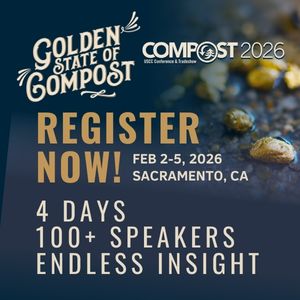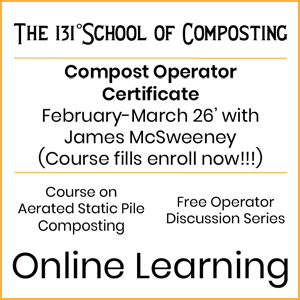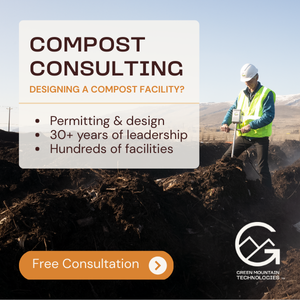
Series examines all the ways compost reduces CO2 in the atmosphere. Part I
Sally Brown
At the recent US Composting Council meeting I got more hi-fives just by touting the benefits of compost from the podium. The conference started with a talk by Katharine Wilkinson, one of the authors of Drawdown. Drawdown ranks 80 different ways that we can actually remove carbon dioxide (CO2) from the atmosphere, drawing down its concentration. If we do this right and now, climate change becomes a chapter in history rather than something that rewrites our history.
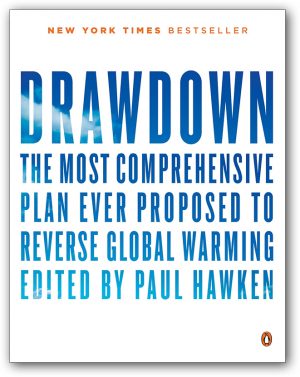 Compost came in at #60 in the Drawdown ranking. That was based on taking food scraps from landfills to compost piles. In other words, the benefit derived from methane avoidance, not from actually using the compost. Don’t get me wrong, methane avoidance is a wonderful thing, something I am happy to be a part of. But this #60 ranking just didn’t sit right. In fact, if you look both above and below that #60 ranking you can find Drawdown options where we know that compost can make a huge difference. These options go the distance from green roofs (#63) to regenerative agriculture (#11) and include options as diverse as temperate forest (#12) and plant -based diets (#4). There are also drawdown options that didn’t make the cut where compost can play a role (burned land recovery). Finally, there are resilience factors where compost comes into play in case we aren’t successful in this drawdown. Drought resilience is just one example.
Compost came in at #60 in the Drawdown ranking. That was based on taking food scraps from landfills to compost piles. In other words, the benefit derived from methane avoidance, not from actually using the compost. Don’t get me wrong, methane avoidance is a wonderful thing, something I am happy to be a part of. But this #60 ranking just didn’t sit right. In fact, if you look both above and below that #60 ranking you can find Drawdown options where we know that compost can make a huge difference. These options go the distance from green roofs (#63) to regenerative agriculture (#11) and include options as diverse as temperate forest (#12) and plant -based diets (#4). There are also drawdown options that didn’t make the cut where compost can play a role (burned land recovery). Finally, there are resilience factors where compost comes into play in case we aren’t successful in this drawdown. Drought resilience is just one example.
Over the next few Connections columns, I’d like to talk about different ways compost can make a difference. By doing so we can decide if compost merits a ranking change. California will be the focus and not just because it has legislation to take organics out of landfills ASAP. California has it all — highways, cities, both high value agriculture (grapes and almonds) and large-scale agriculture (rangeland). Californians have had their share of wildfires and droughts. I think Frank Sinatra would forgive me here as I paraphrase and change locations: If compost can make it there, it’ll make it anywhere. It’s up to you California.
A Few Fundamentals
Climate change isn’t just the earth heating up. Calling it global warming (even though the average temperature is clearly rising) is hard to swallow when climate change can mean snow in May. I think of it as the taking away the Prozac. We have had a very chill, measured climate for about 5,000 years. You can think of it as the atmosphere on antidepressants. No temper tantrums, no wild swings in temperature or precipitation. Relatively calm, cool and collected. But our atmosphere is wild at heart. Take away the Prozac (increase CO2 in the atmosphere) and out comes the mood swings and the bipolar behavior.
Atmospheric mood swings take the form of torrential rains followed by extended droughts, fierce tornadoes and vicious hurricanes. This can make watching the weather channel almost as good as watching a horror movie. It makes it very difficult however, for mundane activities like growing wheat and living near the ocean.
We use changing concentrations of CO2 in the atmosphere as the metric for how far along this climate change has progressed. Carbon dioxide has always been in the atmosphere — and it is critical to earth being someplace where we can live, breathe and eat. A great way to understand this is to look at the equation for photosynthesis:
6CO2 (atmospheric CO2)+ 6H2O (water) —-> C6H12O6 (basic formula for sugar) + 6O2 (the oxygen)
This describes how plants take carbon from the atmosphere (as CO2) and turn it into leaves, roots and shoots. This plant matter is the basis for everything that we eat as well as for the fossil fuels that got us into trouble in the first place. A by-product of this reaction is the oxygen that we breathe.
Unless you live in the tropics, every year you see the cycle of growth and decay. Plants fix CO2 and make the world green and sweet smelling during the spring and summer. Come fall and winter, we eat that fixed carbon and return a good portion back to the atmosphere for next year’s cycle. Every time we breathe out (same with all other organisms that breathe) our breath contains 4% to 5% CO2. That is about 100 times more CO2 than we breathe in. That CO2 comes from the fixed carbon (food) we eat for energy.
Despite how good CO2 is for growing things, too much of it in the atmosphere is a problem. As a molecule CO2 is very good at absorbing the heat from the earth and holding onto it. You know how hot it gets during the day in the summer and if you are lucky enough to live in certain places (Seattle) how it always cools down at night? If you live in other places, that daytime heat may diminish but it never disappears. Brooklyn comes to mind as a good example. This is due in part to humidity. It turns out that water vapor is also excellent at trapping heat. In the summer, Seattle has no humidity and Brooklyn has plenty. Increasing CO2 in the atmosphere works to transform Seattle into Brooklyn — at least in terms of holding onto heat.
This is the start of the California road trip. Next stop will be a review of the basics of methane and why methane avoidance is so important and what got us to #60. After that we go over the Drawdown rankings and see where else compost can come into play. The trip will end by talking about whether compost can really rocket up the list. So stay tuned and buckle up.
Sally Brown, BioCycle’s Senior Adviser and long-time Connections columnist, is a Research Professor in the College of the Environment at the University of Washington.
Part II


